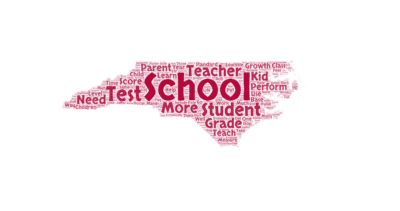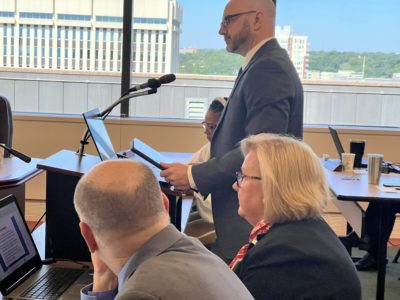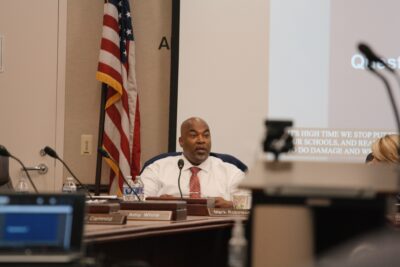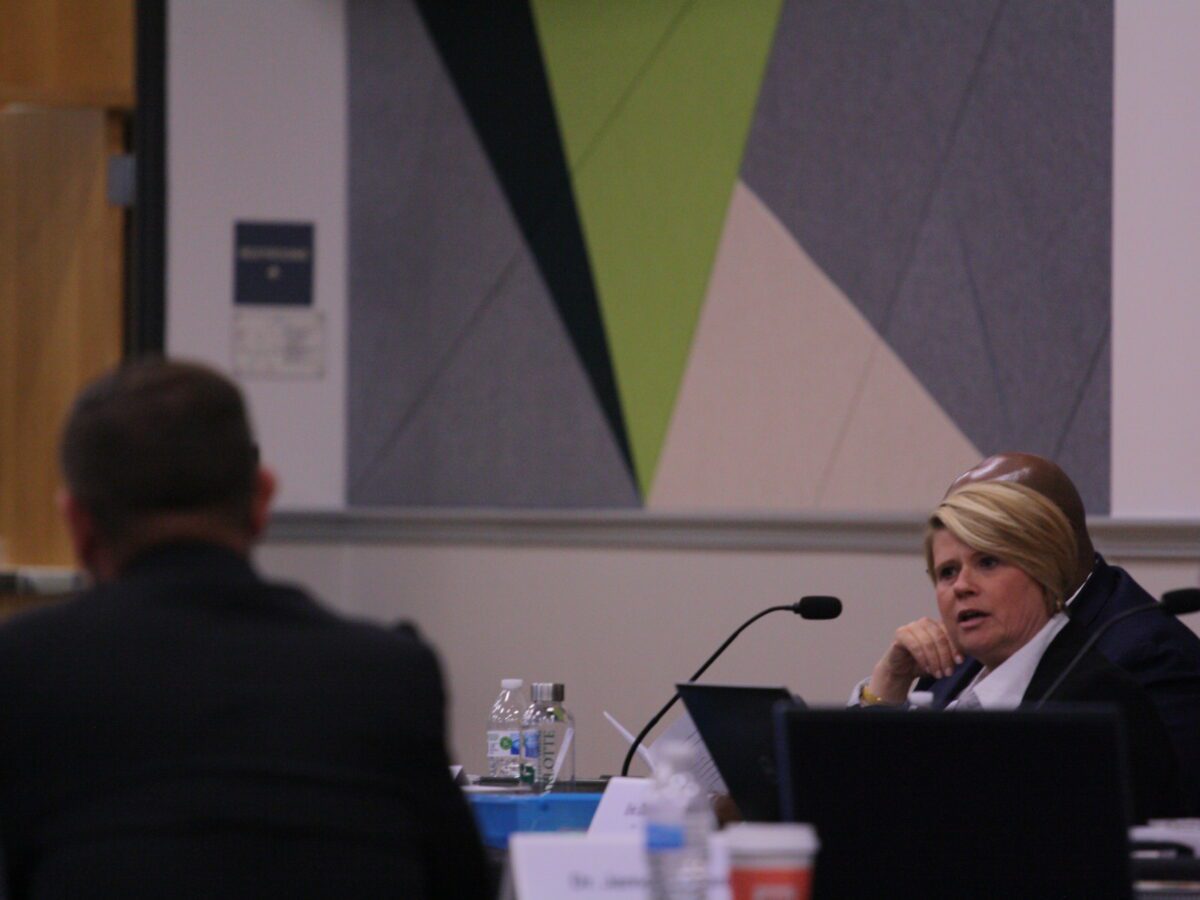
Share this story
- Currently, school grades are based on each school’s achievement score, weighted 80%, and students’ academic growth, weighted 20%. The goal is to pilot the new indicators during the 2024-2025 school year. #nced
- The Center for Safer Schools presented an update on statewide safety initiatives, including hiring a parent/community engagement administrator, offering additional trainings, and increasing mental health supports.
|
|
The State Board of Education continued its work on new measures of school accountability, safety initiatives in schools, and educator preparation at its biannual planning session and monthly meeting last week at UNC-Charlotte.
The board’s work throughout the three-day meeting focused on the goals of the board’s strategic plan: improving school district performance, increasing educator preparedness, and eliminating opportunity gaps to meet the needs of every student.
On Wednesday, Board member James Ford thanked his colleagues for their collaboration in forming and refining the strategic plan.
“I think we set a precedent and culture of working across lines of difference, being critical friends to each other, and finding ways to adhere to the mission and the mantle of the State Board of Education,” said Ford, who represents the Southwest Education Region. He is also the executive director of CREED, the Center for Racial Equity in Education.
“So as we execute our strategic plan – and have effectively extended it for an additional two years until 2027 as a result of the disruption caused by the Covid pandemic – meetings like this just become all the more important,” he said.
Sign up for the EdWeekly, a Friday roundup of the most important education news of the week.
As EdNC has previously reported, it is no secret that state leaders think it’s time to reconsider the accountability model used to give schools performance grades across North Carolina. Currently, school grades are based on each school’s achievement score, weighted 80%, and students’ academic growth, weighted 20%.
In January, the N.C. Department of Public Instruction (DPI) unveiled possible new indicators and weighting changes, after convening a working group to redesign the accountability model last fall. That work included input from a survey by EdNC.
Last week, DPI provided an overview of those eight proposed indicators to members of the board, along with a timeline of the second phase of the redesign process.
“The multiple measures are so important – we want to tell the story of a school,” said Leah Carper, adviser to the board and the 2022 Burroughs Wellcome Fund North Carolina Teacher of the Year. “That performance grade does not tell the whole story of the school, so we’re very excited for this work. I think the way we roll it out to educators, we have to tell the story of this work to them.”
Moving forward, work groups will meet starting May 9 through Oct. 31 to refine the indicators. There will be monthly email communication regarding the current status of the phases, per the presentation, with bimonthly meetings to discuss progress.
If House Bill 26 becomes law, DPI would be required to report to the Joint Legislative Education Oversight Committee on suggested changes to the school evaluation model by Feb. 14, 2024.
DPI will share the policy proposal with the State Board of Education before it shares the proposal with lawmakers. The goal is to then pilot the indicators during the 2024-2025 school year.
Here is the timeline for phase two of the process:
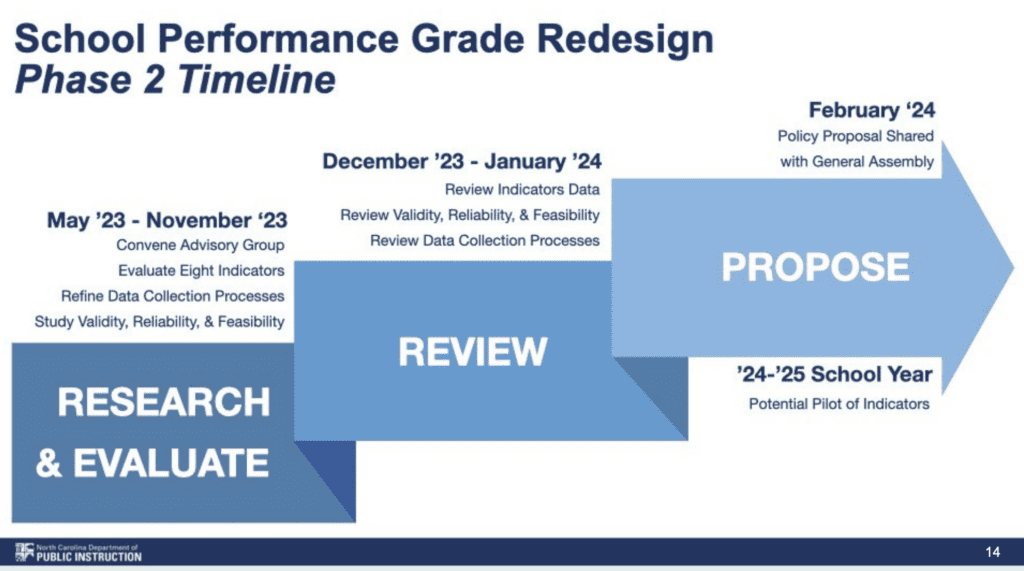
The eight proposed indicators are broken into academic indicators and school quality indicators. For each indicator, it is important to note whether it would apply to elementary, middle, and/or high schools. In addition, some indicators would be required, while others would be a district or school choice.
Here are the definitions of the four academic indicators, per DPI’s presentation:
- Extended high school graduation rate: the percentage of students who graduate within five years (adjusted cohort graduation rate).
- Improving student group performance: increase in student group achievement from previous year, with definition to be determined with input from working group.
- Postsecondary outcomes – Employed, enlisted, enrolled: the percentage of graduates who either have confirmed acceptance (defining if this means enrollment) in a postsecondary institution, enlistment in the military, or employed (defining if this means employability).
- Postsecondary preparation inputs: elementary school – the percentage of students who participate in a career exploration activity; middle school – percentage of students who have a career development plan; high school – percentage of students who fulfill potentially at least one of a defined list of post-secondary preparation programs/classes/certifications
Here are the definitions of the four school quality indicators:
- Extra/intra curricular activities: the percentage of students who participate in extracurricular or intra-curricular activities.
- Durable skills: identified qualities cited in Portrait of a Graduate.
- Chronic student absenteeism: the percentage of student whose absences exceed 10% of days in membership.
- School climate: percentage of students and teachers who affirm the qualities of a school related to engagement and environment.
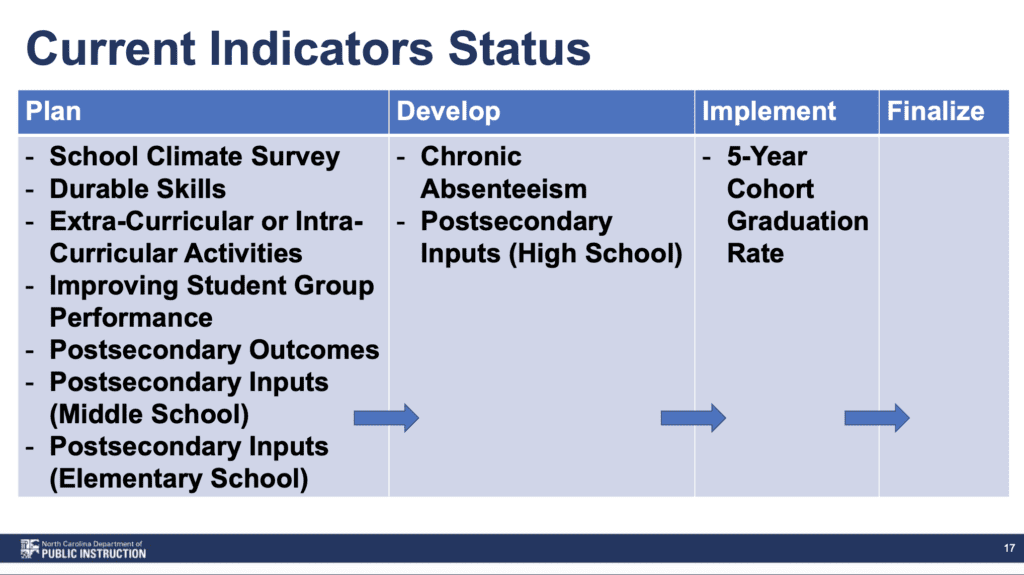
You can view DPI’s full presentation on school performance grade redesign here.
Safety initiatives in schools
Last month, State Board of Education members discussed the urgency of increasing school safety in response to gun violence.
Schools across North Carolina saw a large increase in crime and violence in 2021-22 compared to 2020-21, EdNC previously reported, though rates were particularly low that year due to COVID-19.
In 2021-22, there were 11,170 total acts of crime and violence, up from 1,535 the year before during the height of COVID-19, according to the annual Consolidated Data Report. There were 7,158 total acts in 2019-20, before the pandemic. Until then, the rates of crime and violence had been dropping every year.
At the board’s April meeting, Superintendent Catherine Truitt also highlighted the 10th anniversary of the Center for Safer Schools (CFSS) and some of the center’s work. She specifically mentioned mental health first aid and EKG2, a training curriculum for seventh graders that teaches “about the legal, medical, and emotional consequences of youth gun possession, substance abuse and related gun violence.”
Last Wednesday, CFSS presented an update on statewide safety initiatives.
“If we all take a step back and think about it, having safe schools is the most important thing we do,” Vice Chair Alan Duncan said last week. “…We’ve got a lot of work to do, I believe, still, to get to the place where I think every one of us so desperately wants to be.”
Chair Eric Davis then asked Dr. Jerry Oates, deputy state superintendent and one of the presenters, to bring back examples of interventions that worked among superintendents at a future meeting, along with how the Board can help.
Employ qualified professionals to offer cultural sensitivity and cultural awareness training to school staff and employees.
Offer trauma-informed care training to school staff and employees.
Implement a statewide discipline matrix.
Include school resource officers in positive interaction, not just classroom behavior management and situations of arrest or other punitive measures.
Recommendations for Improving School Climate and Culture, the Center for Safer Schools
Karen Fairley, the center’s executive director, gave the following updates on the center’s initiatives, among others:
- The center is in the process of hiring a parent/community engagement administrator. That administrator will be supported by an upcoming committee of 24 parents – one parent from each of the eight regions will be from a charter school, and two parents from each region will be from school districts.
- The CFSS is working with the Justice Academy and Samarcand Training Academy to enhance cultural sensitivity and awareness training to school resource officers as a request from the Task Force for Racial Equity in Criminal Justice.
- Pending legislation, the CFSS plans to hire a director of mental health, along with three mental health professionals to focus on school safety.
- The centers offers Behavioral Threat Assessment training quarterly. More than 1,000 school staff have been trained to date.
- The CFSS will offer training for trauma-informed care and human trafficking prevention for school-based professionals during the summer.
- The center is meeting with its multi-disciplinary team to assist with a statewide discipline matrix. The organization secured an intern to work on the initiative.
That statewide discipline matrix is part of the State Board of Education’s work to address inequities in rates of student discipline among certain subgroups of students.
The short-term suspension and expulsion rates examined at the board’s March meeting were particularly high when it came to Black and American Indian students, and students of two or more races. The long-term suspension and expulsion rates were particularly high among Black, and Native Hawaiian/Pacific Islander students.
During the March meeting, Ford said he continues to be bothered by the data when it comes to students of color. He has been attending Board meetings in some capacity since serving as an adviser to the Board as teacher of the year back in the 2014-15 school year.
“I have to confess … I can feel my heart rate increasing, my blood pressure increasing. I just get nauseous,” he said at the time. “It assumes that either there’s something wrong with the students … or we’re assuming that there’s something wrong with the system that’s playing itself out in racial terms that are undeniable.”
Last week, Board members reviewed a new strategic dashboard monitoring tool with DPI staff, including data on exclusionary discipline and chronic absenteeism.
Group members noted the disproportionate discipline rates among students of color compared to the state’s overall rate. Clear and consistent definitions are important, several staff and board members said, reflecting the need for consistent codes of conduct across the state.
“You cannot legislate culture, you cannot make policy that is going to institute culture – you have to model and be the change,” Truitt said regarding such trends. “…The best shot we have at seeing the change we want is having an accountability model that very clearly lays out what we value in terms of school culture.”
Educator preparation
The Board has recently approved for several community colleges to offer the Elementary Education Residency Licensure Certificate Program, effective fall 2023.
Last month, the Board offered initial approval to Blue Ridge and Wayne community colleges for the program.
Last week, the Board approved for Alamance, Central Piedmont, Fayetteville Technical, McDowell Technical, and Western Piedmont community colleges to offer those education prep programs as well. The Board also offered initial approval for 11 more colleges, presented for action at first reading. Those colleges were: Brunswick, Catawba Valley, Davidson-Davie, Durham Technical, Forsyth Technical, Johnston, Lenoir, Richmond, Sampson, Stanly, and Wake Technical.
Those new programs makes teacher licensing more affordable and convenient by allowing prospective teachers to take classes at local community colleges, according to a February release from the N.C. Community College System (NCCCS). Historically, the vast majority of N.C. teachers come from the UNC System.
Truitt clarified on Thursday that none of those colleges are becoming four-year schools or granting four-year degrees.
Dr. Olivia Holmes Oxendine, chair of the State Board of Education’s educator standards and practice committee, said in April that she expects to see additional community college approvals in the next few months.
“North Carolina community colleges are making it easier and more affordable to become an elementary school teacher in your community,” NCCCS Interim President Dr. Bill Carver said in February. “We are committed to supporting the needs of the state through education programs that quickly and appropriately prepare graduates for vital classroom responsibilities.”
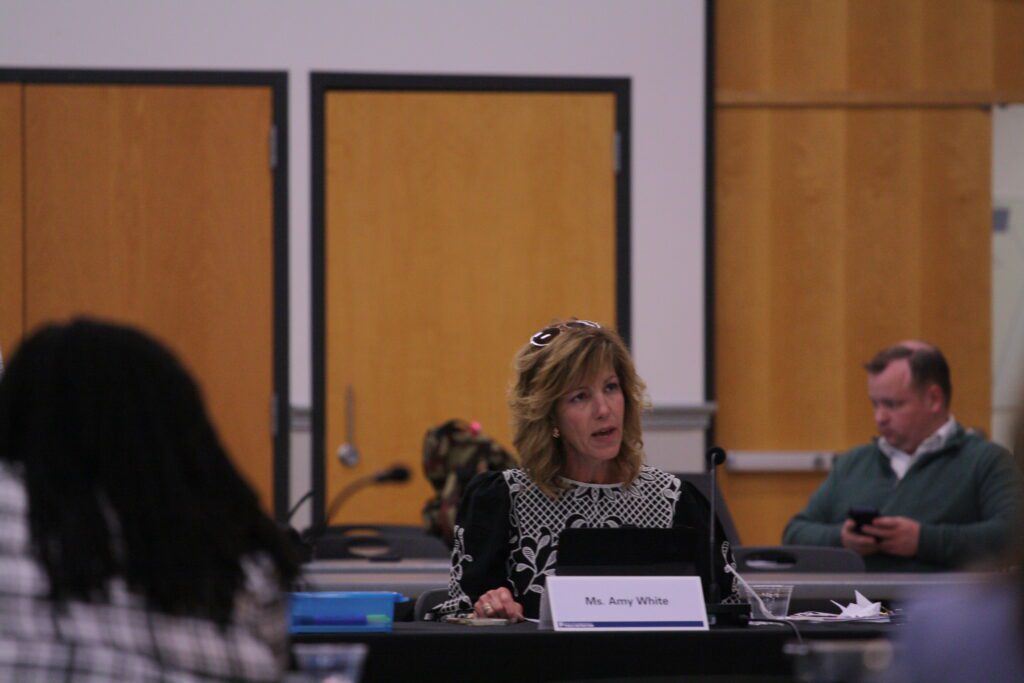
Other meeting items
- Board member Amy White announced she will retire from the Board to focus on her work leading Community of Hope Ministries. Her seven-year team is expiring, but she could have stayed until lawmakers confirm her replacement. Her last meeting will be next month’s meeting.
- DPI’s Director of Government Affairs Jamey Falkenbury gave a report on this year’s legislative session. More than 70 bills made the crossover deadline last week, he said, including more than 30 education bills. The DPI team is tracking 100-150 bills due to the crossover exception for bills with fiscal impact, he said. You can view the full crossover list here, and EdNC’s reporting from before the crossover here.
- Board members discussed the possibility of drafting rules for high school athletic eligibility, including rules for transgender students. The Board considered four options last week and will vote in June. If statewide legislation requiring transgender athletes to play on teams assigned by their “reproductive biology and genetics at birth” passes, that would supersede the Board’s policy.
- In a 5-4 vote, the Board approved N.C. Virtual Academy’s expansion request for the 2023-24 school year. The state’s two virtual charter schools launched in the 2015-16 school year as a pilot program and have consistently been designated by the state as low-performing schools. There were 2,849 applicants on the waitlist for the 22-23 school year, according to the request.
- The Board discussed the 2022 Charter Schools Annual Report, which is due to the General Assembly by June 15. This is the first year the report includes academic data for charters. EdNC will have more on this report soon. In the meantime, you can view the report here.
The Board meets next for its regular meeting May 31 through June 1. The next planning session is scheduled for Oct. 31 through Nov. 2.
Recommended reading
